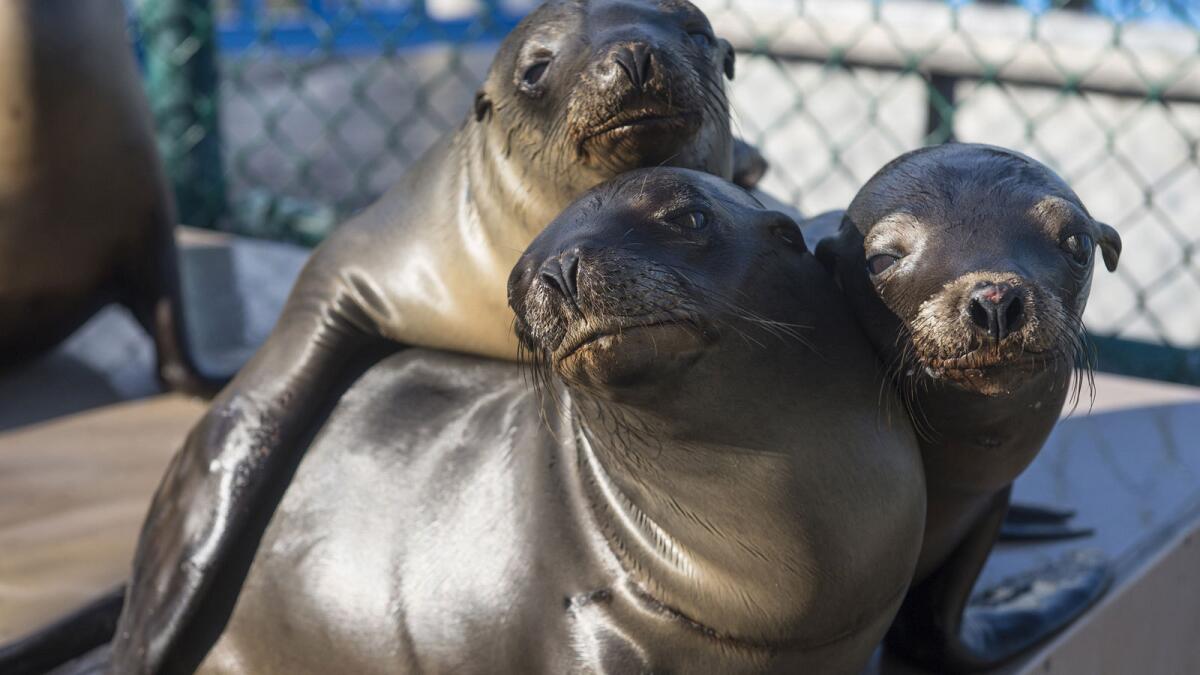Sea lions wash ashore: 3rd straight year of record strandings

- Share via
This year is shaping up to be a brutal one for the California sea lion -- the third straight year for record numbers of sea lion strandings in the state.
Sick, abandoned pups have shown up in alarming numbers on beaches in January.
“Their growth is stunted,” said Shawn Johnson, director of veterinary science at the Marine Mammal Center in Sausalito, Calif. “They’re basically starved to death -- no muscle, no fat, just skin and bones.”
But pups aren’t the only ones in trouble. California marine mammal rehabilitation centers this month have treated record numbers of sea lions of all ages.
“We’ve had 67 strandings of sea lions of all different ages,” said Johnson, whose center would normally see one, maybe two, sea lions in the entire month of January. “The whole population is getting hit hard.”
“It’s a real shock to us,” he added.
The story’s much the same in Southern California.
“It’s shaping up to be a very, very bad year as far as rehabilitation,” said David Bard, operations director at the Marine Mammal Care Center in San Pedro. There were 75 animals at the center as of the end of January. Like its sister center in Sausalito, the facility was seeing a wider age range of sea lions in January, as well as a greater cross-section of species.
The San Pedro center has seen “double the numbers we saw in the middle of January 2013” -- the year of an Unusual Mortality Event.
The National Marine Fisheries Service declared the UME in 2013 – a phenomenon characterized by an unexpected number of strandings and significant die-off of a marine mammal population.
Scientists thought the huge number of strandings in 2013 was an anomaly, Johnson said.
“But then it happened again last year, and now it’s happening again.”
The marine mammal centers in Northern and Southern California were not affected equally by strandings in 2013 and 2014, he added. In 2013, Southern California centers saw a huge influx of sea lions. Then in 2014, Northern California facilities were swamped.
Sausalito’s Marine Mammal Center, which averages 600 animals a year, responded to 1,030 animals, Johnson said. Of those, “711 were sea lions, mostly pups, but again it was spread over all the age classes.”
January 2015, however, has been “extremely unusual” for the Northern California center, he said.
In winter, the sea lion population is concentrated in Southern California, then shifts northward in late summer, Johnson said. So for the center to see so many animals is cause for further concern.
What’s going on?
Experts have floated various theories. It could be illness or an environmental cause.
There have been 60 UMEs in the U.S., for various marine mammals, since 1991. A cause has been determined in 29 of those cases, according to the National Oceanic and Atmospheric Administration. Some are chalked up to infection. But since 1996 biotoxins from harmful algae blooms have been to blame in a majority of the UMEs, NOAA says. The biotoxins accumulate in the mammals’ prey.
Another possibility is “the sea lion population is reaching carrying capacity,” Bard said.
California sea lions were exploited in the 19th and early 20th centuries for their hides and blubber and continued to be hunted for sport in some areas later in the 20th century. The Marine Mammal Protection Act of 1972 led to dramatic increases in the populations of marine mammals, Johnson said. And the population is now abundant – 300,000, said NOAA Fisheries spokesman Jim Milbury, with a birth rate of about 50,000 a year.
The environment just may not be able to support a larger sea lion population.
It’s also possible the sea lions’ prey has shifted, Johnson said: “Maybe the fish have all left, and that’s why this is happening. We’re hoping for some answers in coming weeks.”
A team from NOAA Fisheries is at Channel Islands now, looking for clues to help solve this 2-year-old mystery, Milbury said.
Although sea lions range from Mexico to Canada, the Channel Islands are where most of America’s sea lions breed. Hordes of the mammals pup in rookeries on the islands.
Scientists have spent time on the islands in the last two years, but this year may bring extra urgency.
“This is the third year in a row that the anomaly has happened,” Johnson noted. “They’re working really hard to try to answer those questions.”
After the 2013 UME, the Marine Mammal Care Center in San Pedro began fund-raising in earnest to expand the facility. It now has two new enclosures for the animals.
“I’m not sure even that is going to be enough,” operations director Bard said.
The centers are under financial stress with the added burden of so many animals to treat. Bard said the center has gotten some funding for part-time husbandry assistants but was recruiting volunteer interns. California’s rehab centers rely heavily on volunteers.
Johnson said donors were crucial with all the extra mouths to feed – in 2014, the center spent $100,000 on herring alone.
“I hope that we have some answers soon,” Johnson said, “so that we can prepare for the future.”
Follow me at @AmyTheHub







